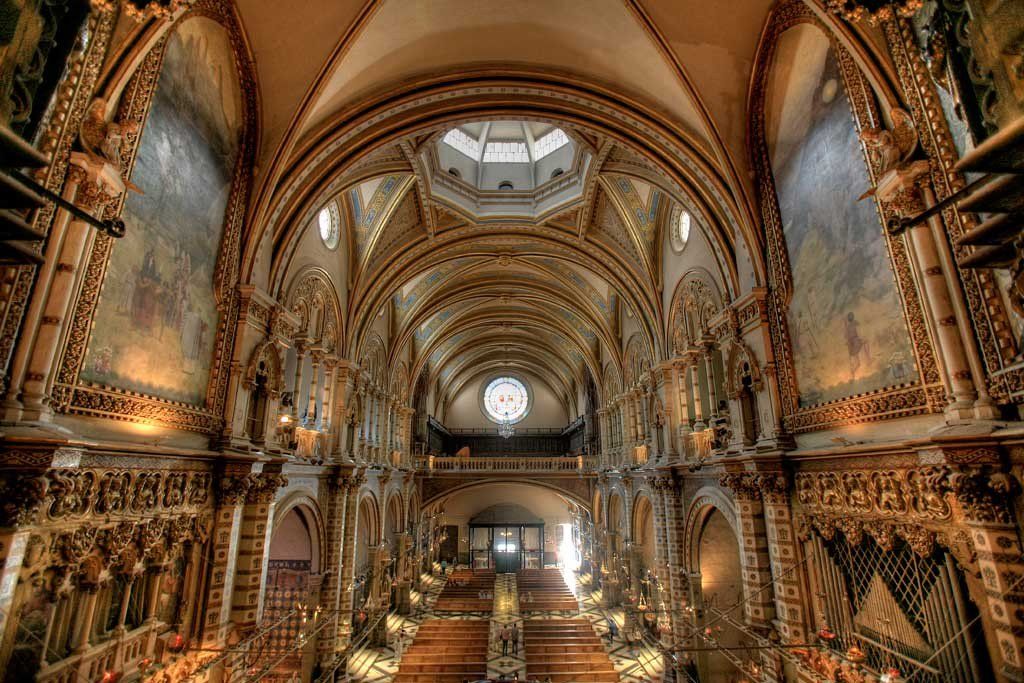Church at Montserrat Monastery, Catalonia, Spain
Page Content
Montserrat Atrium and Basilica from afar
The Basilica is the name for the church at Montserrat. For most people it is essential to a visit to Montserrat for three main reasons. Firstly, it is, in itself, a Gothic building of architectural significance. Secondly, it is the home of Montserrat’s masses and choral concerts. Thirdly, it houses what is arguably Montserrat’s most important feature – the statue of the Black Madonna.
This page will provide details on the history of the Basilica. You will also find the opening times of the Basilica and where it is located, plus accessibility of the building for limited mobility visitors.
Book tickets for your half day tour to Montserrat from Barcelona with return journey
There are two organized tours that save you the time and trouble of organizing your own trip to Montserrat. They include return journey from Barcelona to Montserrat in an air conditioned bus. You can choose either a half day morning tour or half day afternoon tour.
Morning Tour
Click here to book your tickets online for the Montserrat Morning guided tour leaving from Barcelona
History of the Basilica
The Atrium of the Basilica
The Floor of the Atrium in Montserrat
The Atrium of the Basilica is the open-roofed courtyard area that sits directly in front of the Basilica. Five arches lead you to the main area. Look out for the iron sculpture of St Benedict by the sculptor Enric Monjo. It is situated at the entrance to the part of the monastery where the monks live – an area that you are not allowed to enter (for more details on the monastery and the lives of the monks who live within it, see our Montserrat Monastery page).
The atrium itself is known as the Atrium of Abbot Argerich. In 1952 – 1956 it was decorated by Josep Obiols and Father Benet Martinez. Designs on the right-hand walls of the atrium depict the most important shrines and basilicas throughout Christianity.
Take a look down and enjoy the marbled black and white floor of the atrium. It takes inspiration from the floor of the Capitolium in Rome that was designed by Michelangelo. The inscriptions at the centre are Latin and refer to baptism.
In front you will be able to take in the facade of the basilica. In 1900 – 1901 a new facade was added to the basilica. It is the work of Francesc de Paula del Villar I Carmona and carved by two brothers – Venanci and Agapit Vallmitjana.
The Basilica
Montserrat’s church is a Gothic structure that also uses Renaissance shapes and traditionally Catalan architecture. It was severely damaged during Napolean’s war (1808 – 1814). This meant that it had to be reconstructed at the end of the 19th century. The central nave of the church is 58 metres long and 15 metres wide. It is 23 metres to the top of the dome of the church.
Around the edge of the church you will note lots of ornate hanging candles.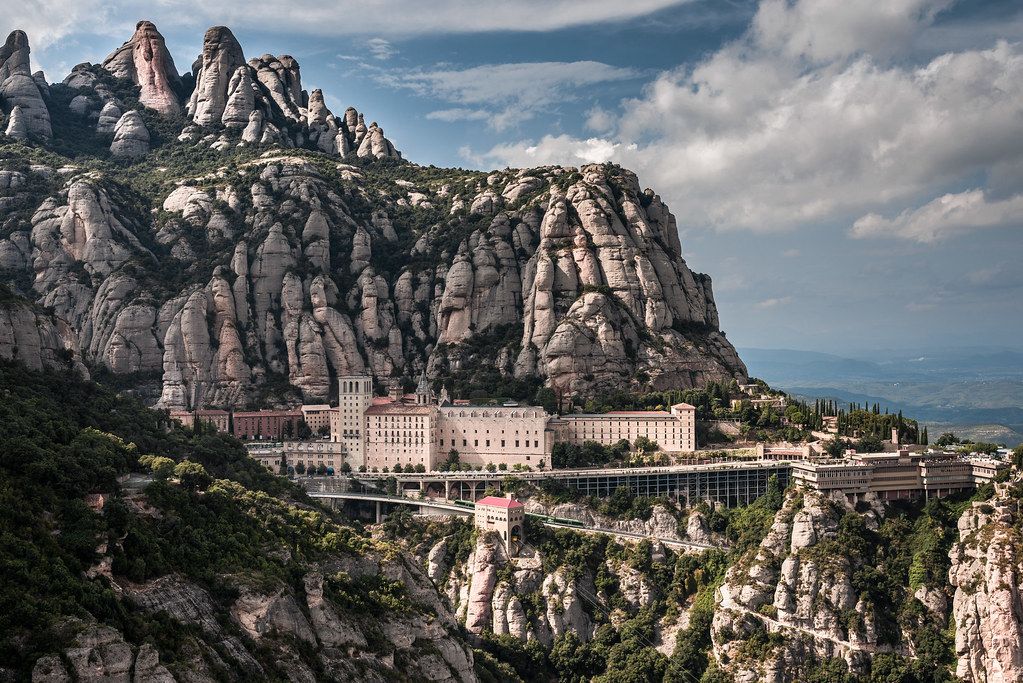
On the central pillars of the nave you will see sculptures of prophets: Ezekial, Jeremiah, Isiah and Daniel. They were all carved in wood by Josep Llimona and were put in place in 1896.
The Chapels in the Basilica
All around the edge of the basilica you will see chapels. There is the chapel of St. Scholastica. It contains sculptures by Enric Claraso and Agapit Vallmitjana. The Chapel of the Most Holy One contains a large stained glass window. This window separates the chapel from the nave. The third chapel contains a painting by Josep Cusachs of the exodus to Egypt. The next chapel is the Chapel of the Holy Christ. There is an image of Christ on the cross that was created by Josep Llimona.
The Black Madonna
The famous Black Madonna sculpture sits at the back of the church, above the altar area. It is framed in an ornate window, and you can see her if you are sitting in the church’s pews. For details on the history of the sculpture, plus information on waiting times to view the statue, disabled access and prices, see our Official Black Madonna page.
Opening times of Montserrat’s Basilica
As a church, the Basilica is open at all hours. However, it is important to remember that public transport to the Montserrat Monastery will stop running in the evenings. Running times for transport options vary throughout the year. For details of the Montserrat rack railway page, Montserrat bus page or Montserrat cable car page, check the page that you need.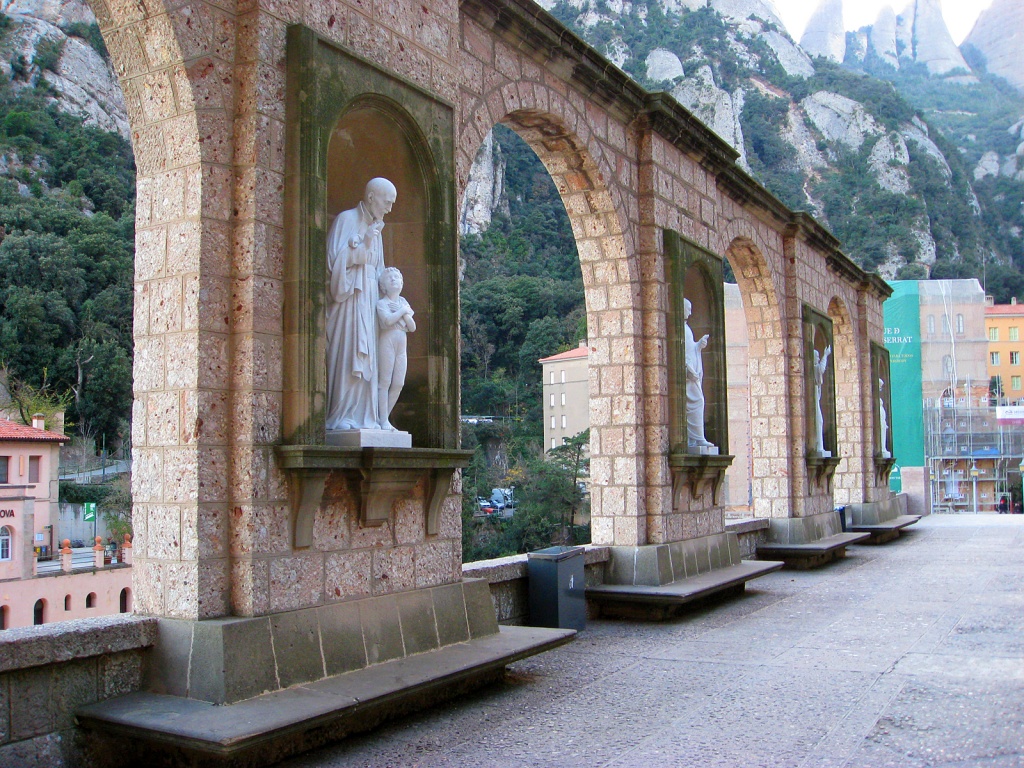
If you would like to attend a mass at the Basilica, check our Masses at Montserrat page for mass times.
If you would like to see the choir sing in the Basilica, check our Montserrat Choir page for choral concert times.
How do I get to the Basilica?
The Basilica sits at the very heart of Montserrat Monastery. For details of how to find it, see our Map of Montserrat.
Disabled access
There is complete disabled access to the Basilica. There is a wide ramp to enter the atrium area and another to enter the Basilica itself. For details of limited mobility accessibility, you can check our disabled access at Montserrat page.
Unfortunately if you have a wheelchair the only area of the basilica that you will not be able to get to is the Black Madonna. However, you will be able to get within two to three feet of the statue. For further details, see our Black Madonna page.
The Basilica at Montserrat Monastery is at the very heart of what the monastery stands for.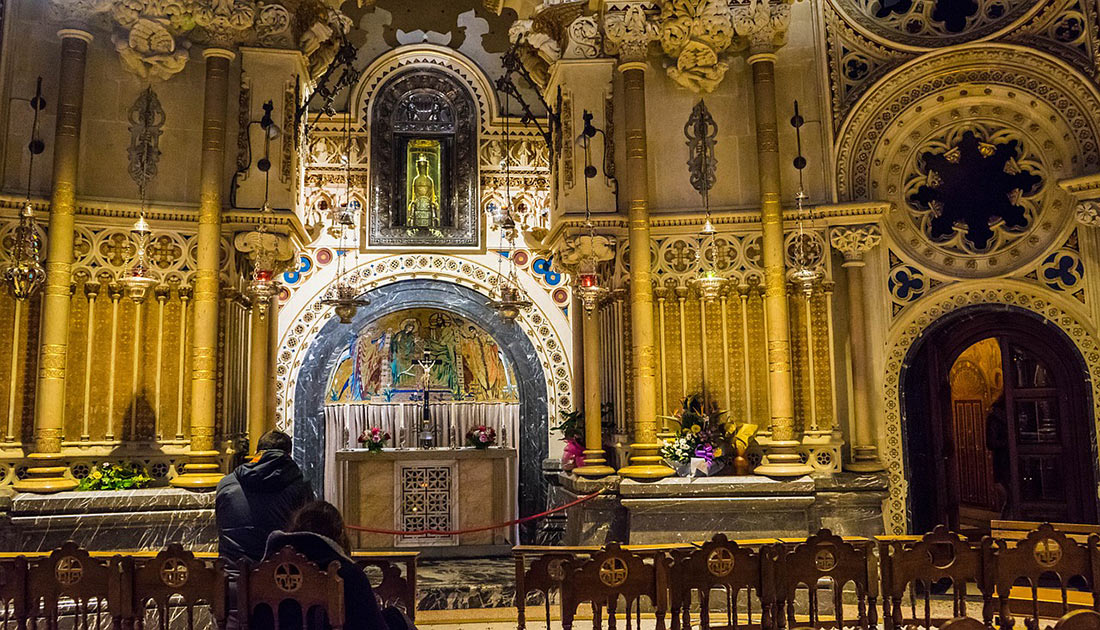
The Montserrat monastery
Even from a distance, the 1,236 meter high mountain offers a magnificent sight. You can also experience the distant view far into the hinterland of Catalonia from above.
The mountain Montserrat with the Benedictine Monastery Santa Maria de Montserrat is located about 45 km northwest of Barcelona. Book various excursions to Montserrat.
Arrival to Montserrat Monastery
Arrival by train
From Plaça Espanya train station, the FGC (Ferrocarrils de la Generalitat) train line R5 (Barcelona Manresa) leaves every hour starting at 8:26 am.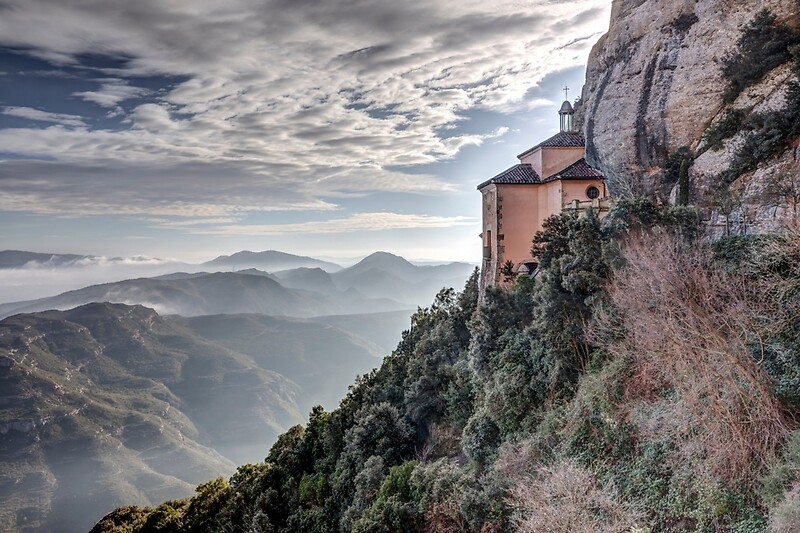
You can find the timetable for line R5 here.
Arrival tickets
Trans Montserrat: Return Ticket and Audiovisual Exhibit
- Explore the impressive Montserrat Monastery and the natural treasures of the nature reserve with the all-inclusive “Trans Montserrat” ticket from Barcelona.
- Ticket Metro Barcelona
- Round trip ticket on the R5 train from Barcelona Plaça Espanya to Monistrol de Montserrat
- Ticket for cable car or rack railway to the monastery
- Ticket for the Santa Cova funicular
- Admission to the audiovisual gallery
- You can determine the outward and return journey yourself
Show prices & availability
Tot Montserrat: Transport, Museum Tickets, and Lunch
- Explore the impressive location of Montserrat with this all-inclusive ticket from Barcelona.
With return train tickets, museum entrances, a Catalan lunch, and unlimited access to the funiculars, take in the delights of Montserrat in style.
- Explore the impressive Montserrat Monastery and the natural treasures of the nature reserve with the all-inclusive “Trans Montserrat” ticket from Barcelona.
- Ticket Metro Barcelona
- Round trip ticket on the R5 train from Barcelona Plaça Espanya to Monistrol de Montserrat
- Ticket for cable car or rack railway to the monastery
- Ticket for the Santa Cova funicular
- Admission to the audiovisual gallery
- Admission to the Museu de Montserrat
- Typical Catalan lunch
- You can determine the outward and return journey yourself
Show prices & availability
From Barcelona: Montserrat Monastery Transfer
- Visit the mountain of Montserrat from Barcelona in a comfortable and air-conditioned vehicle with this low cost option. See the basilica of the monastery, and choose to visit the museum, or take some of the breathtaking walks to different viewpoints.
- Self-guided stay on Montserrat
- Transfer by air-conditioned vehicle from Barcelona city center directly to Montserrat Monastery
- Photo stops to photograph the beautiful landscapes
- Duration 5 hours
Show prices & availability
Change to the cable car at Aeri de Montserrat station, or go one station further to Monistrol de Montserrat station. From there, a cogwheel train runs every 20 minutes up Montserrat, directly to the monastery. Well worth the 15 minute drive. The price for the rack railway and cable car is €12.00 each (return ticket, adults).
Arriving by car
Anyone arriving by car or motorbike will truly enjoy one of the most beautiful serpentine roads in Spain.
It is easy to get there: A2 motorway, Martorell exit, then take the N II national road to the Montserrat junction. Approximately 70 km to drive from the center of Barcelona. You can already see the peculiar shape of the mountain from the highway. Montserrat means “sawed mountain”.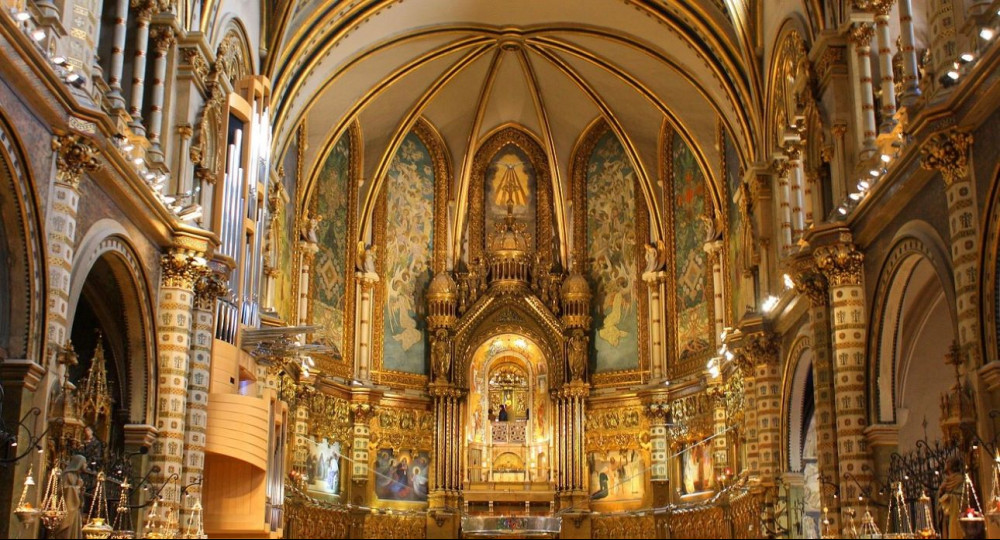
Excursions to the monastery and natural park of Montserrat
In addition to the Tot- and Trans-Montserrat tickets for your own arrival and many extra services, you can also have a good time: book a private or open excursion and experience a beautiful day in a wonderful setting.
Hiking in Montserrat Natural Park
From the monastery itself it is about 300 meters to the summit of Montserrat. A cog railway runs almost to the summit. From there you can hike several well-developed and signposted hiking trails through the Montserrat Nature Park. Several hiking trails of different lengths lead from the top station of the funicular to the abandoned hermitages. In any case, you will be rewarded for the effort of the hikes with an overwhelming view of Catalonia.
Although the paths are well developed, you should definitely wear sturdy shoes. A medium level of fitness is sufficient to master the paths. Please do not leave the hiking trails to protect the sensitive and sparse vegetation!
Montserrat Monastery
The massif is in the middle of a very beautiful nature park.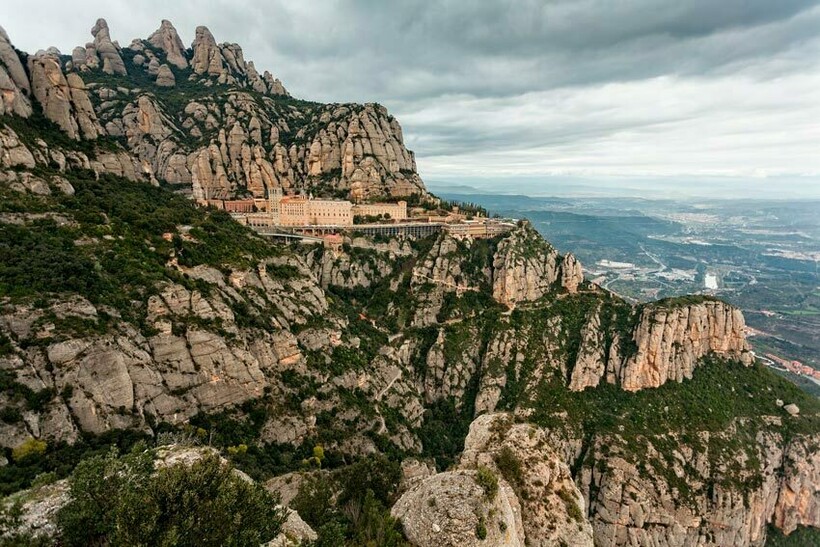
Bird’s-eye view of Montserrat
Arriving at Montserrat Monastery, you have an indescribable view all the way to Barcelona. However, the view of the city itself is not possible because of the Conserolla Mountains.
The monastery of Montserrat itself is not a special attraction from an architectural point of view, the scenery into which the walls were built is inspiring. Many of the tourists come just for the statue of the Black Madonna, patron saint of Catalonia. The 12th-century figure is enthroned above the high altar in the monastery’s basilica. In her honor, around 50 choirboys of the “Escolania de Montserrat” of the monastery’s boarding school sing church songs – Salve Regina and Virolai – every day (Monday to Saturday at 13.00 by the boys’ choir of the monastery school, Sundays and public holidays at 12.00).
In the Montserrat Monastery Museum you can see works by important artists such as Dalí, El Greco, Monet and Giordano.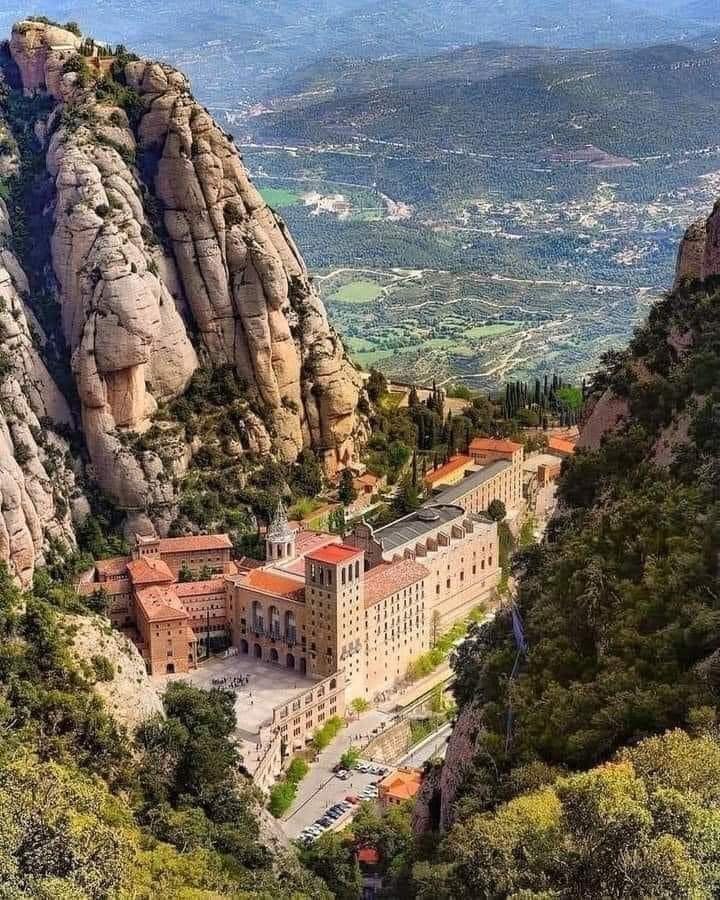
In the lower part of the monastery area there is a restaurant where you can eat and drink quite cheaply.
The boys’ choir Escolania de Montserrat
The Escolania is the oldest music school in Europe. The choir was first mentioned in a document in 1307. About 40-50 students from 9 to 14 years go to the school. They can also spend the night there and also spend their free time there. But it’s not a boarding school.
The parents of the choirboys pay 20% of the school fees, a large part of which is covered by the Catalan Ministry of Education. A foundation pays the rest. If parents are unable to pay their share of the school fees, the “Fundació Abadia de Montserrat 2025” will also take care of this.
In addition to singing, the students learn piano and another instrument of their choice.
Knabenchor Escolania de Montserrat
History of Montserrat
Montserrat Mountain has had religious significance since pre-Christian times.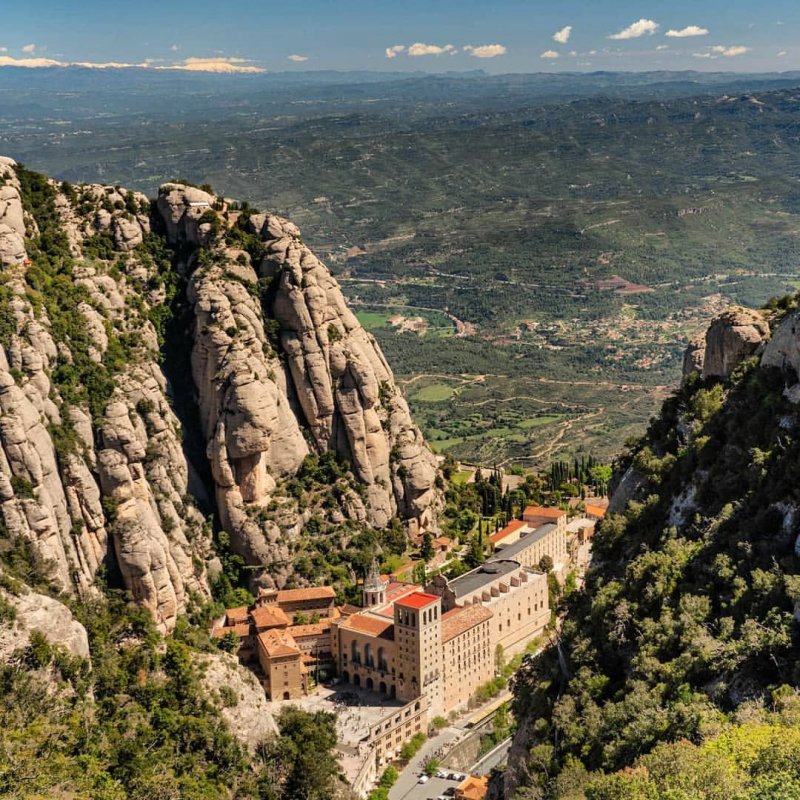
Miracles are attributed to the Black Madonna found in the 12th century, which is still the destination of pilgrimages today. The monastery owed its strong growth to these ascribed miracles.
The basilica of the monastery was built in the 16th century, in the transition period between Gothic and Renaissance. The Black Madonna is kept in the basilica.
Many famous people made pilgrimages to Montserrat: Pope Benedict XIII, Columbus, Cervantes, von Humboldt, Kings Fernando and Isabella, Carlos I, Felipe II and Louis XIV.
On his second voyage in 1493, Columbus named an Antilles island Montserrat.
In 1811 the monastery was largely destroyed by Napoleonic troops.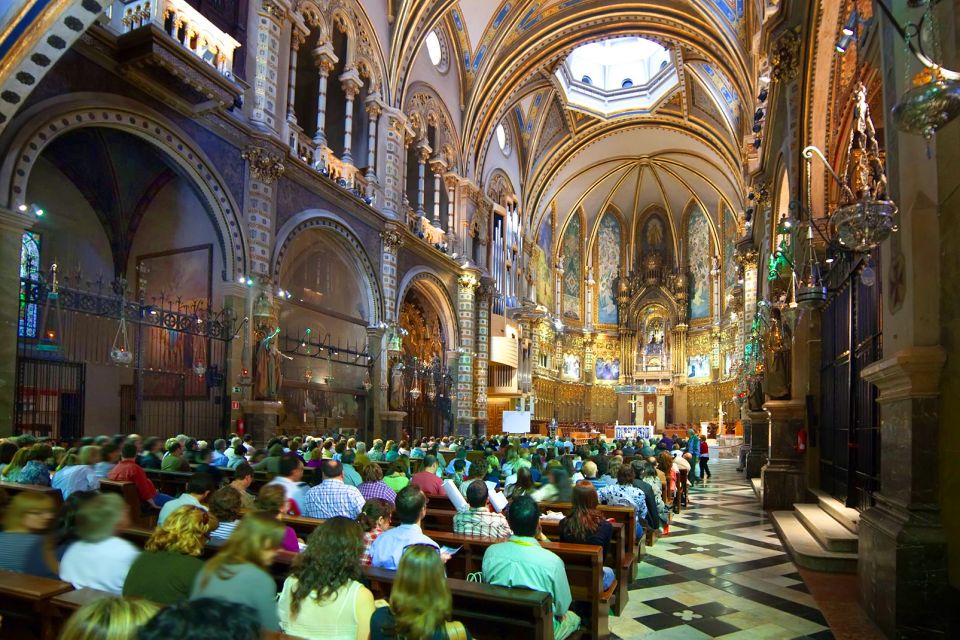
The monastery resisted during the Franco dictatorship. Despite the ban, Catalan was still spoken there and masses were held in Catalan. Hundreds of people persecuted by the Franco regime were hidden here. More than 20 monks were executed because of it.
Today, this resistance makes the monastery an important symbol of Catalan self-evidence and the fight against oppression. The Catalans are still grateful for that today.
Transfers from Barcelona to Montserrat
(Click on the product images to view prices and availability)
Topseller guided Montserrat excursions
- Private Montserrat tours, you have the guide exclusively for you
- Open Montserrat excursions, you and other guests in a group
(Click on the product images to view prices and availability)
Other excursions from Barcelona
Montserrat – Dalí and the Dalinian Triangle – Girona – Balloon Ride – Roca Village Outlet – Estrella Damm brewery tour – Amusement park PortAventura – Horseback riding – Sitges – Costa Brava – Wine and Cava – Formula 1 and MotoGP in Catalonia – Pyrenees and Vall de Núria
Montserrat Church, Catalonia, Spain
Page Content
Courtyard and Basilica of Montserrat from afar
Basilica is the name given to the church attached to the monastery of Montserrat.
On this page we will introduce you to the history of the basilica. There is also information on the opening hours of the basilica, its location plus its accessibility for the disabled.
Book your tickets for a half day excursion to Montserrat from Barcelona round trip
There are two organized tours that will save you time and hassle to travel to Montserrat on your own. They include round-trip travel from Barcelona to Montserrat by air-conditioned bus. You can choose a half-day tour in the morning or in the afternoon.
Morning Tour to Montserrat
Click here to purchase tickets online for Morning Tour to Montserrat from Barcelona
History of the Basilica
Basilica Courtyard
Montserrat Courtyard
The Basilica Atrium is an open courtyard located directly in front of the Basilica.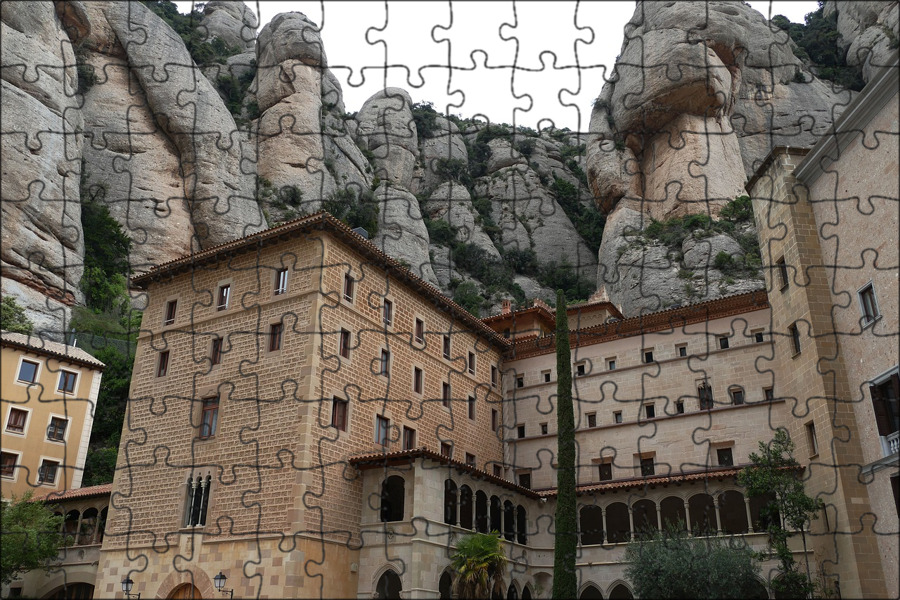
The atrium itself is called the atrium of the Abbot Argerich. In 1952 – 1956 the atrium was decorated by Josep Obiols and Father Benet Martinez. On the walls on the right are the most significant churches and basilicas for Christianity. The walls on the left depict a brief history of Montserrat.
Look down at your feet and marvel at the black and white marble floor of the atrium. When creating the floors, the authors were inspired by the Roman Capitol, the decoration of which was designed by Michelangelo himself. In the center you can see inscriptions in Latin, which speak of baptism.
Standing in the atrium, you can admire the facade of the basilica.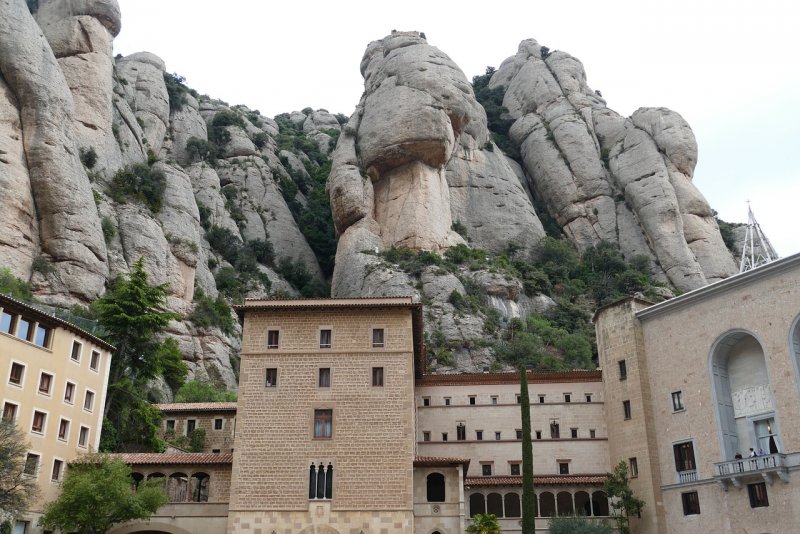
Basilica
The church of Montserrat is a gothic building, which also contains forms from the Renaissance and traditional Catalan elements of architecture. During the Napoleonic Wars (1808 – 1814) the basilica was seriously damaged. So at the end of 19century, the basilica had to be restored. The main hall of the church is 58 meters long and 15 meters wide. The dome of the church is 23 meters high.
Patterned candelabra hang on the walls of the church. They are made in the typical Catalan style of jewelry making, which came into vogue after the Spanish Civil War (1811 – 1812). All candelabra were donated to the church by the Catalan cities and various communities. They were installed in the church to emphasize the presence at the feet of the Virgin Mary of Montserrat of the people of Catalonia.
On the columns of the central hall you can see the statues of the prophets: Ezekiel, Jeremiah, Isaiah and Daniel. They were carved from wood by Josep Llimona and put back in place in 1896.
Chapels in the Basilica
Chapels can be seen throughout the Basilica. There is a chapel of St. Scholastica. Inside are sculptures by Enrico Claraso and Agapit Valmitjan. There is a large stained-glass window in the chapel of the Holy One. It separates the chapel from the main hall of the basilica. In the third chapel there is a painting by Josep Cusacs dedicated to the exodus of the Jews from Egypt. The next chapel is named after Jesus Christ. There is an image of Christ on the cross, created by Josep Llimona. The Chapel of the Immaculate Conception was opened at 1910 year. It is decorated in a style that reflects the admiration of architect Josep M. Pericas for Antoni Gaudí, making this chapel a good example of Catalan architecture.
Black Madonna
The famous statue of the Black Madonna is located at the back of the church, above the altar.
Opening hours of the Basilica of Montserrat
As a church, the basilica is open around the clock. However, do not forget that in the evening public transport from Montserrat stops walking. The transport schedule depends on the season. Read more about transport in our articles on rack railway to Montserrat, buses to Montserrat or cable car to Montserrat.
If you would like to attend mass in the basilica, you can find out the hours of the masses in our article on masses in the Basilica of Montserrat.
If you would like to attend a choir performance in the basilica, please see our article on the Montserrat choir for a schedule of performances.
How can I get to the Basilica?
The basilica is located in the heart of Montserrat monastery.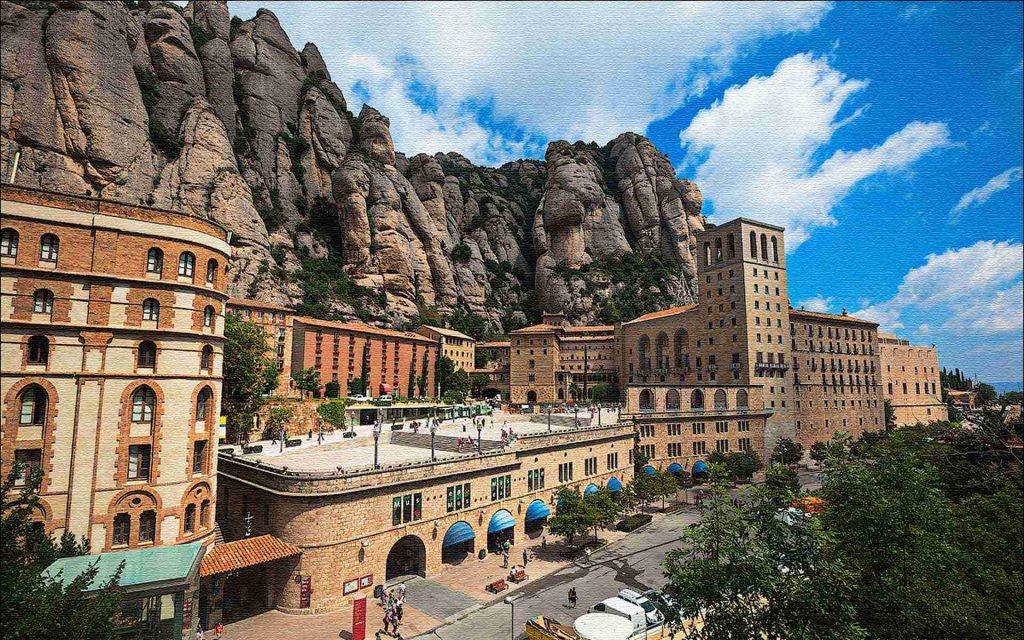
Accessibility for the disabled
The Basilica is fully wheelchair accessible. There are wide ramps in front of the entrance to the atrium and to the basilica itself. For more information on barrier-free environments for the disabled, see our article on accessibility of Montserrat for the disabled.
Unfortunately, if you are a wheelchair user, the only place in the basilica that you cannot enter is the place where the statue of the Black Madonna stands. However, you will be able to get within a few meters of the statue. Read more about this in our article on the Black Madonna.
The basilica of Montserrat is located in the heart of the monastery. If you are on a religious pilgrimage to the monastery, you will be touched by the spirituality of this place, plus you can see the Black Madonna. If you are hoping to hear a chorale, then you will have the opportunity to see the performance of the choir in the basilica.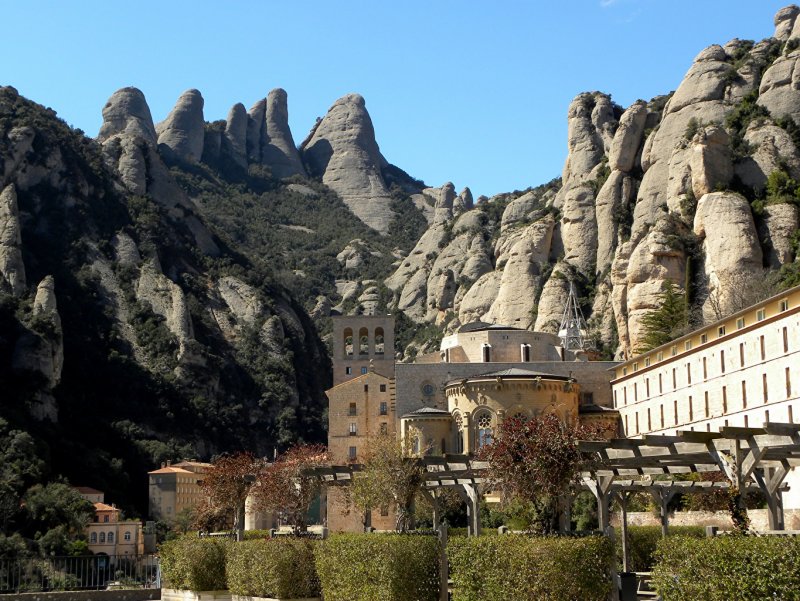
Montserrat Monastery in Catalonia Spain
Page Content
Basilica of Montserrat Monastery
In one form or another, Montserrat Monastery has existed on Mount Montserrat since the ninth century (details later in the section “History of Montserrat Monastery”). This page will introduce you to the history of the Montserrat monastery and the life of the monks living there.
There is also a link to a page with contact details for the Monks of Montserrat and information on how to contact them.
Book your tickets for a half day excursion to Montserrat from Barcelona round trip
There are two organized tours that will save you time and hassle to travel to Montserrat on your own. They include round-trip travel from Barcelona to Montserrat by air-conditioned bus. You can choose a half-day tour in the morning or in the afternoon.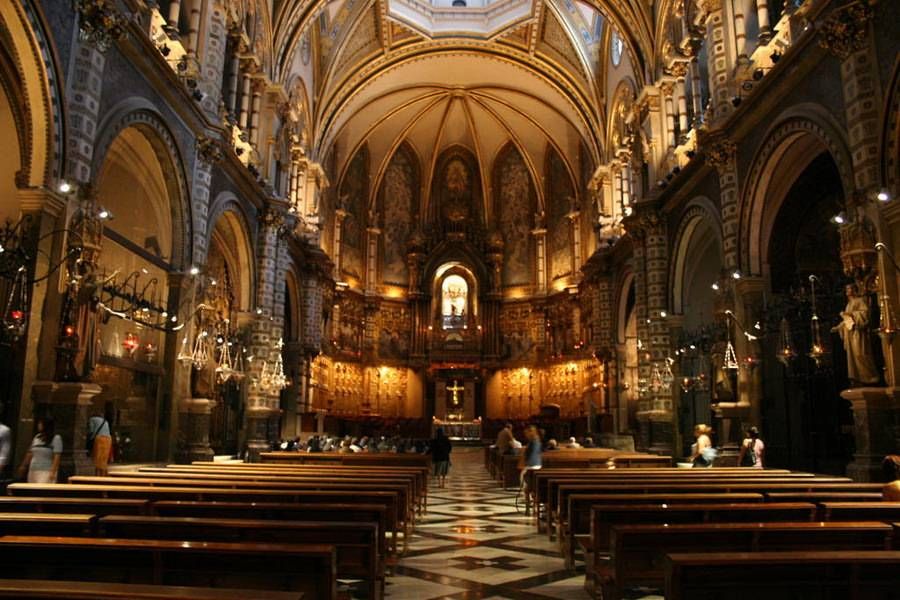
Morning excursion to Montserrat
Click here to purchase tickets online for the morning excursion to Montserrat from Barcelona
If you are interested in more general information about Montserrat and the Basilica in general, you should read our article on Montserrat Tourist Attractions. This article has links to detailed articles on the Black Madonna, the L’Escolania Choir, the Montserrat Funiculars, the Montserrat Nature Reserve, the Montserrat Museum and the Montserrat Shops.
History of Montserrat
It is not known exactly when the monks first came to Montserrat and began to build the Monastery. However, four chapels are believed to have been built on Montserrat in the ninth century (Saint Mary, Saint Iscle, Saint Peter and Saint Martin). It is believed that hermit monks lived there in solitude and prayers. One of those chapels has survived to this day – the chapel of St. Iscle. If you want to see the chapel of Saint Iscle, it is located in the monastery garden (you can find it using our map of Montserrat).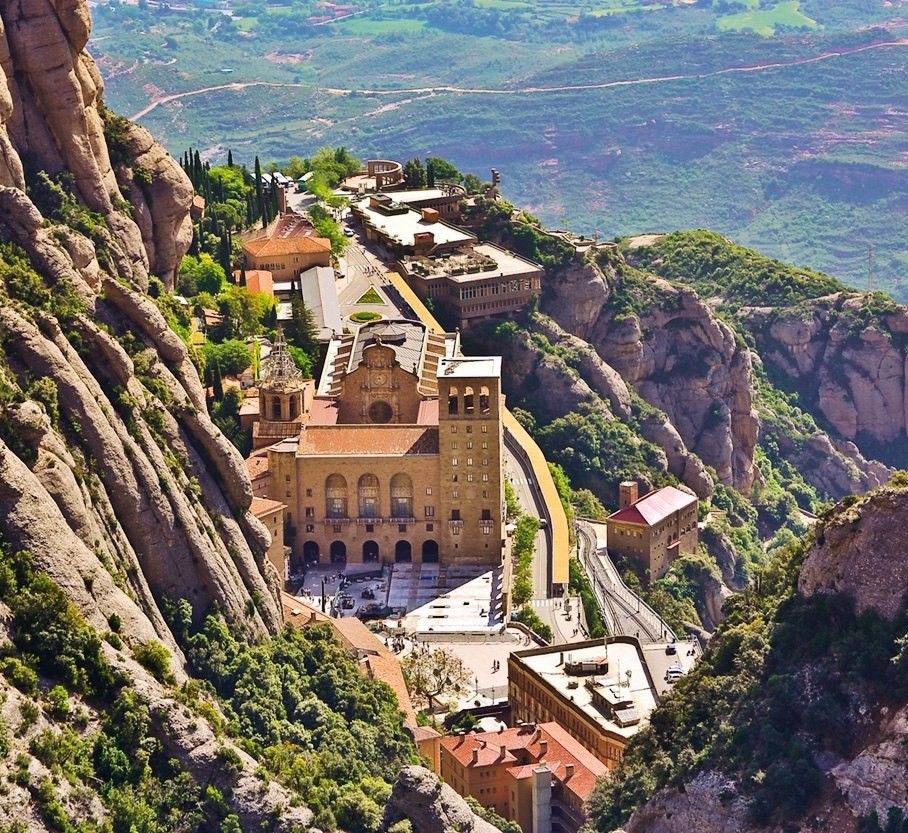
In 1025 the abbot of Ripoli and the bishop of Vic, Oliba, officially founded the monastery of Montserrat. During the twelfth and thirteenth centuries, a Romanesque church was built in the Montserrat monastery, in which the figure of the Virgin was carved. During this period, pilgrims began to flock to Montserrat.
In the following centuries, the importance of the Montserrat monastery only increased: the first mention of the boys’ choir in Montserrat dates back to 1223, in 1409 the monastery became an independent abbey, and in 1490, a printing press was installed in Montserrat. In 1493, the monastery was heard far beyond the borders of Spain, one of the monks of the monastery, Bernal Boil, went to America with the expedition of Christopher Columbus. One of the Antilles was named after Montserrat, and thus began the worship of the Virgin of Montserrat in America.
In the 19th century, Montserrat Monastery experienced a difficult time. In 1811 – 1812 Montserrat was destroyed by the Napoleonic army.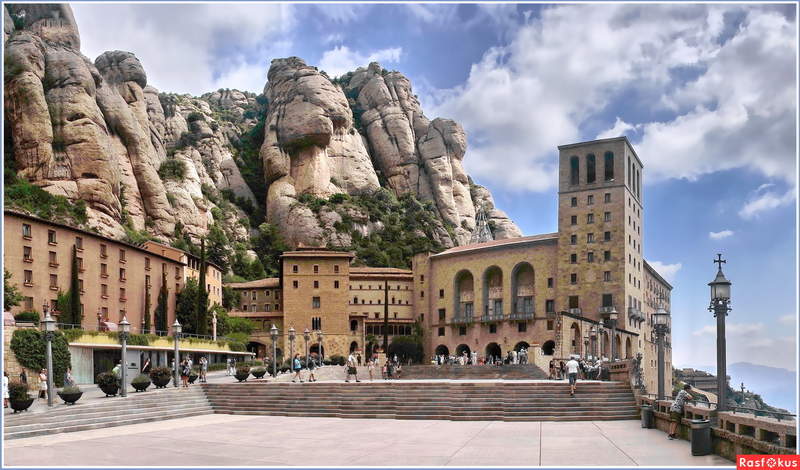
Again, already in the twentieth century, the monks experienced difficulties during the Spanish Civil War (1936-1939). During this period, the monks were forced to leave the monastery. During the entire war, 23 monks were killed. Fortunately, the autonomous government of Catalonia managed to save Montserrat from looting and destruction. After the war, the monks returned and continued to rebuild the monastery.
In 1947, the day of the enthronement of the image of the Mother of God (Black Madonna) was celebrated. Since that day, the monastery has only flourished. A new museum was built, at 19In 82, the monastery was visited by Pope John Paul II, the basilica was restored, and a whole complex was built for the needs of a large number of pilgrims who annually come to the monastery.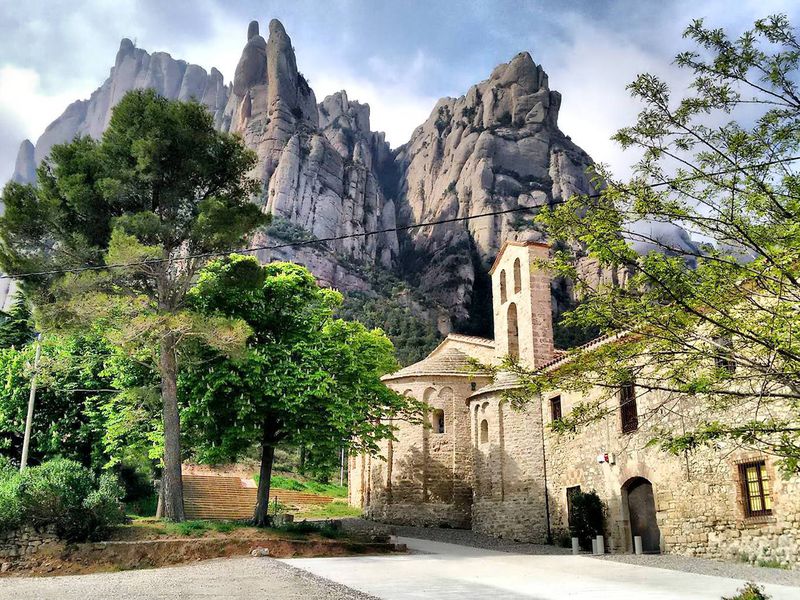
The life of the monks in the monastery
About a hundred monks live in Montserrat. They are members of the Benedictine order and are associated with two other monasteries – El Miracle and St Micheal of Cuixa. They devoted their lives to prayer and work. Benedictine monks differ from monks of other orders in their philosophy, the essence of which is that each person is priceless in his own way. They gladly host a variety of people in their monastery.
Monks hear the voice of God through holy statues, various events in the church and global events in the world.
Monks do many different things. Some deal with the internal problems of the monastery. Others serve as scholars or teachers in areas such as history, theology, biblical studies, liturgy, and music. Other monks work in the basilica – they meet pilgrims to the monastery, give speeches and do chores at the monastery. Other monks work with the famous monastery choir L’Escolania. They teach boys how to sing choirs, compose and study music, and produce music recordings.

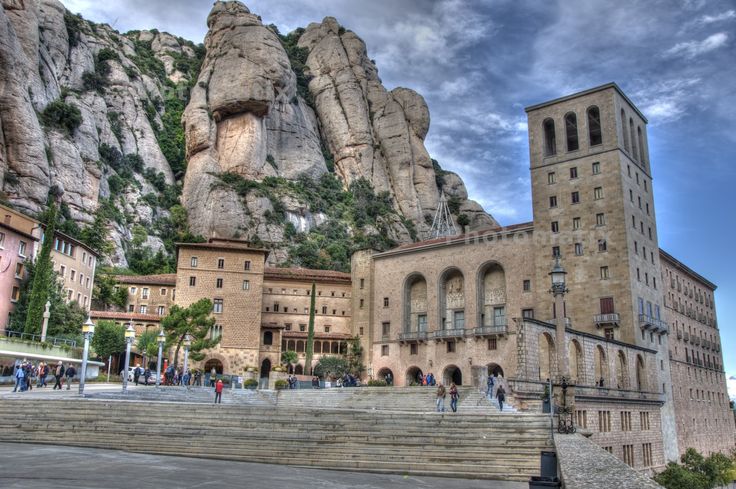 With return train tickets, museum entrances, a Catalan lunch, and unlimited access to the funiculars, take in the delights of Montserrat in style.
With return train tickets, museum entrances, a Catalan lunch, and unlimited access to the funiculars, take in the delights of Montserrat in style.
